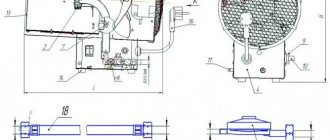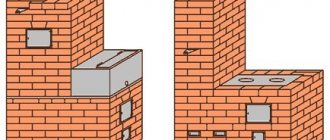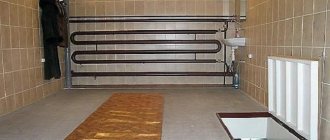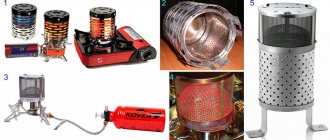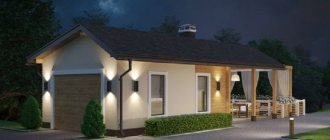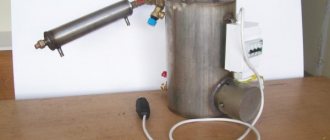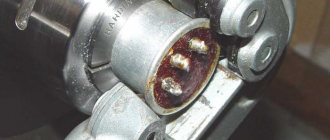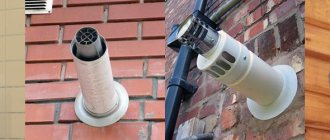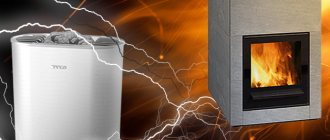For most car enthusiasts, as cold weather approaches, the question arises of how to heat the garage. One of the ways to achieve a comfortable temperature is heat guns, essentially powerful fan heaters. A heat gun consists of a heating element and a fan. Thanks to the cylindrical shape of the housing, the air passing through the heating element reaches a high temperature, and a powerful fan allows you to heat the air in the room in a short time.
Heat guns got their name because of their shape. Made in the form of a pipe mounted on a wheeled platform, they resemble cannons from Tsarist times. The presence of small wheels makes it easy to move these heating devices from one room to another.
How to choose the right heat gun for your garage?
First of all, you need to calculate the power of the heater. User experience suggests that to heat 25 cubic meters of garage, 1.5 kilowatts of gun power is needed, despite the fact that the temperature “overboard” will be about zero degrees. If the temperature reaches 10 - 15 degrees below zero, then two or even three times more power will be required.
Having correctly calculated the power of the heater, we select a suitable heat gun for the garage
To understand which heater is best for your garage, you need to know:
- how many resources the device will consume, and their cost;
- how long will people work with the warm device on;
- how fireproof this unit is;
- Is the garage insulated, and how well?
How to determine the required power of a heat gun
This is the most important and difficult point when choosing a heat gun. It is necessary to determine how much power will be enough to maintain a comfortable temperature in the garage at a given outside temperature.
To do this, you can use a simple ratio: 0.8−1.4 kW of thermal power per 10 m2 of garage area (with a ceiling height of 2.5 m). That is, for an average garage it is enough to take a gun with a power of up to 3 kW (and if you need a reserve in case of severe frosts - up to 5 kW), and a comfortable temperature will be ensured in it. However, powerful heat guns create significant stress on the wiring, which can lead to trouble.
Heat guns for garages of different capacities
For a more accurate calculation, you can use a simple formula:
Q = Vxt1-t2xkx0.1 163
Where V is the volume of the room, t1 is the required temperature in the room, t2 is the outside air temperature, k is the thermal insulation coefficient of the walls of the room. Multiplying by 0.1 163 is necessary to obtain a numerical value expressed in kW (since the formula derives the amount of heat expressed in calories, and 1 kW/h is equal to 860 kcal/h).
Thermal insulation coefficients for various materials have been derived experimentally, and they are approximately as follows:
— Garage made of simple wooden boards or metal — k=3...4; — Brickwork in one row with thermal insulation of medium thickness — k=2...2.9; — Brickwork in two rows with good thermal insulation — k=1…1.9; — High-quality thermal insulation of walls and roof — k=0.6...0.9.
This way you can calculate the required heat output of the gun for any type of room. However, as already mentioned, for garages you can use guns at a rate of up to 1.4 kW per 10 m2 of area, and in most cases this will be more than enough.
Choosing a heat gun
The main parameter when choosing a product is its power; excess power will waste the meter, and a deficiency will simply not be able to provide sufficient heating of the garage. Experts, through measurements and various experiments, have established that 10 m2 of any private garage can be heated with 1 kW of thermal power if the ceiling height is within 3 m.
Therefore, in the case when the area of your premises is no more than 25 square meters. m, then you need to buy a device with a power of at least 2.5 kW, and given the severe frosts, it won’t hurt to increase the power to 5 kW. It should be taken into account that you will turn on the unit at full power only in exceptional cases. Which gun is right for you - decide for yourself.
Types of heat guns
Electric heat guns
A heat gun, the main resource of which is electric current, is similar in principle to a regular hair dryer. The heating element, in most cases a heating element, and the dimensions of the device are slightly larger than those of a household hair dryer. An electric heat gun for a garage is powered by a standard single-phase network, but a gun with a power of five kilowatts or more is connected to a three-phase network. The device contains a temperature relay, which controls the device, turning it off if the temperature in the garage has reached the required level, and vice versa. Before purchasing this heater, you need to make sure that the electrical wiring in the garage can withstand the load consumed.
Electric heat gun
Pros of an electric gun:
- Relatively small device dimensions;
- Low noise level during operation;
- No open fire.
Disadvantages of this type of gun:
- High cost of electricity;
- The need for power or quality wiring in the garage.
Gas heat guns.
A gas heat gun, as the name suggests, runs on liquefied propane-butane gas. The use of such a heater requires the presence of a gas cylinder of any volume. The principle of operation is that a gas burner is installed inside the cylindrical tube of the gun, which ignites the gas and heats the air. A powerful fan allows you to distribute hot air throughout the garage as quickly as possible. These heaters have a piezo element for easy ignition. All gas guns are direct combustion heaters and do not have the ability to remove exhaust gases from the room. Although guns of this type consume gas economically and do not emit many combustion products, it is still necessary to take care of ventilation in the garage. For ventilation, you can ventilate the room from time to time, but in this case, heat will also leave the garage with exhaust gases.
Gas heat gun
Interesting: Operating at a power of 10-15 kilowatts, a gas heat gun will consume half a liter of gas in 60 minutes.
Advantages of gas heat guns:
- Economical gas consumption;
- Due to its low weight, it is easy to transport to other rooms;
- Compact dimensions allow you to place it anywhere;
- High performance, will help quickly heat the garage;
- Availability of a carbon dioxide concentration sensor.
Upsetting nuances of operation:
- A gas cylinder is required;
- High-quality ventilation is needed;
- Noise during operation;
- The presence of a flame does not allow you to leave the device unattended.
Gas guns
Gas guns operate on liquefied or natural gas.
Gas guns are divided into two types: stationary and mobile. The former are connected to the main gas pipeline, the latter are connected to the cylinder.
Advantages of gas guns:
- high efficiency
- wide range of models from 10 to several hundred kilowatts
- cheap fuel
- Despite the presence of overheating protection and a built-in flame control system, gas guns are classified as potentially dangerous units. In addition, oxygen is burned during the operation of the heat gun.
- To use gas guns in the garage, ventilation must be provided, since combustion products enter directly into the room.
- Work without personnel supervision is not allowed
Diesel heat guns
The main fuel of diesel heat guns is diesel fuel, or diesel fuel. For the operation of this heater, it does not matter what quality of diesel fuel is used, so it is especially convenient for those who have access to cheap fuel. Working on diesel fuel requires a fuel tank, and this increases the weight of the unit. On average, a twenty-liter fuel tank lasts for 10 to 15 hours of operation, while the thermal power will be approximately 30 kilowatts. Diesel guns are essentially the most powerful compared to other types.
Diesel heat guns
Diesel heat guns are divided into two types: with direct and indirect heating.
- Direct combustion. The operating principle of a direct heating gun is similar to a gas heat gun. The fuel is supplied through a pump to the combustion chamber, where the air is heated and dispersed throughout the garage using a fan. Combustion products also remain in the room and require ventilation.
- Indirect combustion. In this case, diesel fuel also burns in the combustion chamber, only the chamber itself does not directly contact the environment, but transfers energy through a heat exchanger. A special exhaust pipe is provided to remove exhaust gases. Although the combustion process still requires oxygen, you will not have to ventilate the room as often.
Advantages of diesel heat guns:
- Low fuel consumption;
- Thermal efficiency 100%;
- Safety of use;
Disadvantages of these guns:
- For direct combustion guns, this is the release of exhaust gases into the garage;
- Units with indirect combustion cost twice as much;
- The presence of a chimney opening for guns with indirect combustion;
- High noise level;
- The weight of the device is about 20 kilograms;
Combined heat guns.
In order to be able to constantly work in the garage, you can combine guns. Initially, you can use a gas heat gun to heat the room, and use a diesel heat gun with indirect combustion to maintain the temperature. In this case, there is no need to constantly ventilate the garage, and at the same time maintain a comfortable temperature. However, this method has one big drawback - the cost of purchasing two guns.
Advantages and disadvantages
Diesel heat guns have a number of advantages in their arsenal:
- good performance in a compact size;
- ease of use (one button control);
- efficiency (low fuel consumption - 0.86 l per 10 kW);
- long time of continuous operation (up to 14 hours).
But any product also has its negative sides. The greatest dissatisfaction among users of diesel heat guns is the excessive noise created by the device during operation. Knowing about this complaint from consumers, manufacturers offer models with reduced noise levels.
The relatively high cost of the device is also mentioned among the disadvantages, but here it is important to really evaluate its effectiveness, and in some situations its irreplaceability. In general, diesel heat generators have a good price-quality ratio. The fuel itself will require material investments, but its consumption is small, so the costs for this expense item will be moderate.
Recommendations for choosing a heat gun for a garage
Based on the above advantages and disadvantages, we can see the following. The use of electric guns is convenient and safe in the sense that they do not require additional conditions, such as a fuel tank or cylinder, a supply ventilation system or a chimney opening in the garage. However, the productivity of such heaters is quite low, and energy consumption is high. In addition, with a weak electrical circuit, it is unlikely that you will be able to do welding and heating at the same time. It's also not safe.
Gas heat guns are more productive, but the consequence of their operation is the presence of carbon monoxide in the garage. And since a garage is usually not a very large room, the concentration of carbon dioxide will be higher and it will be more tedious to ventilate the room. If this is not done, then a process of poisoning of the body occurs. Therefore, a gas heat gun is not the best option for heating a garage.
Diesel heat guns are “above all praise.” Although they have the largest dimensions of all guns, there is still room in the garage to install this unit. Of course, the high cost of an indirect combustion gun is its disadvantage, but productivity makes up for all the shortcomings. Such a gun allows you to safely heat the garage without harming the health of the owner. It is fireproof because the fuel, when ignited, does not come into contact with the environment. On it, like on any other gun, you still cannot dry things and gloves. It also requires 220V power to operate, but does not require a power line or high quality wiring. Electricity is needed to operate the fan, and any electrical network can handle its power consumption.

